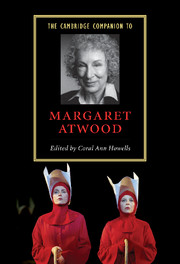Book contents
- Frontmatter
- Introduction
- 1 Margaret Atwood in her Canadian context
- 2 Biography/autobiography
- 3 Power politics: power and identity
- 4 Margaret Atwood’s female bodies
- 5 Margaret Atwood and environmentalism
- 6 Margaret Atwood and history
- 7 Home and nation in Margaret Atwood’s later fiction
- 8 Margaret Atwood’s humor
- 9 Margaret Atwood’s poetry and poetics
- 10 Margaret Atwood’s short stories and shorter fictions
- 11 Margaret Atwood’s dystopian visions: The Handmaid’s Tale and Oryx and Crake
- 12 Blindness and survival in Margaret Atwood’s major novels
- Further Reading
- Index
12 - Blindness and survival in Margaret Atwood’s major novels
Published online by Cambridge University Press: 28 November 2006
- Frontmatter
- Introduction
- 1 Margaret Atwood in her Canadian context
- 2 Biography/autobiography
- 3 Power politics: power and identity
- 4 Margaret Atwood’s female bodies
- 5 Margaret Atwood and environmentalism
- 6 Margaret Atwood and history
- 7 Home and nation in Margaret Atwood’s later fiction
- 8 Margaret Atwood’s humor
- 9 Margaret Atwood’s poetry and poetics
- 10 Margaret Atwood’s short stories and shorter fictions
- 11 Margaret Atwood’s dystopian visions: The Handmaid’s Tale and Oryx and Crake
- 12 Blindness and survival in Margaret Atwood’s major novels
- Further Reading
- Index
Summary
As Reingard Nischik notes, Atwood is “one of the most important literary chroniclers of our time” and an international bestseller; thus, the Atwood industry is “booming.” According to Coral Ann Howells, “From The Edible Woman onwards, her novels have focused on contemporary social and political issues,” challenging contemporary social myths and fashionable ideologies and “endlessly surprising her readers with her ongoing experimentalism.” Critics have viewed Atwood's novels using formalist, biographical, psychoanalytic, feminist, Jungian, dialogic, intertextual, phenomenological, narratological, cultural, postmodern, postcolonial, generic, and deconstructionist approaches. Atwood's novels are variously described as realism, romance, ghost story, thriller, memoir, Bildungsroman, Kunstlerroman, science fiction, metafiction, anti-novel, fairy tale, satire, parody, Gothic, dystopian, nationalist, feminist, revisionist, modernist, intramodern, postmodern, and postcolonial.
As I suggest in Margaret Atwood’s Textual Assassinations, “The issues of power and sexual politics that mark Atwood’s earliest work have evolved.” In addition to the self-divided, alienated, and oppositional characters and character pairs Sherrill Grace helped us recognize with Violent Duality (1980), by the eighties and nineties
- Type
- Chapter
- Information
- The Cambridge Companion to Margaret Atwood , pp. 176 - 190Publisher: Cambridge University PressPrint publication year: 2006
- 4
- Cited by



